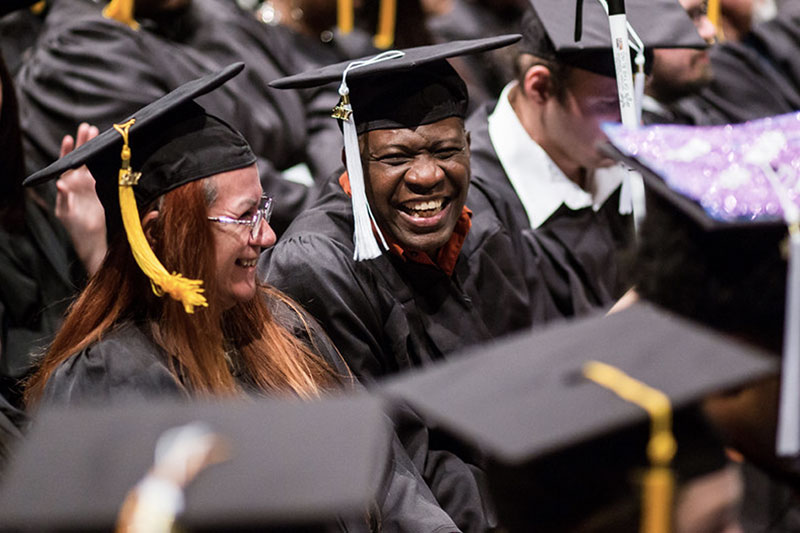By Jenny Schanker
This blog is the second in a four-part series highlighting progress toward the nation’s goal that six of every 10 adults will earn a college degree or other valuable credentials beyond high school—and showcasing what’s possible.
Massachusetts is known as our nation’s most educated state, thanks to its 114 colleges and universities and highly rated public elementary and high schools. But when it comes to closing racial equity gaps—in Massachusetts and every state—more progress is urgently needed.
Massachusetts higher education leaders first heard the call in 2009 when Lumina Foundation galvanized state policymakers to meet its national goal of 60 percent of Americans earning college degrees or credentials by 2025. At the time, Massachusetts’ college attainment rate was 50 percent, with historic inequities producing serious gaps in opportunity, such as a 20 percentage point difference between attainment for white students (53 percent) and Black students (33 percent).
To learn more about the state’s work to close equity gaps, Sova, Lumina’s research partner, spoke with Commissioner Noe Ortega, Ph.D., and Assistant Commissioner for Academic Policy & Student Success and Chief of Staff Elena Quiroz-Livanis, at the Massachusetts Department of Higher Education, along with other educators and community leaders. “We need to find ways to unpack the lack of sufficient progress on racial equity while celebrating that general improvement is happening,” Ortega said.
State leaders stepped up to increase affordability, enrollment, retention, and equitable outcomes. Notably, they invited students to the table to help shape policies, show what’s missing, and keep the focus on their most urgent needs.
Today, with a 62 percent attainment rate, a new free community college program for adults, and a statewide strategic plan for racial equity, the Commonwealth is a national leader in helping all students learn and innovating to close equity gaps for students of color.
Steps toward progress
In interviews with Sova, Massachusetts leaders highlighted some key steps on the road to progress:
- A 2009 OECD Education at a Glance report that put the U.S. in the middle of the pack for adults with degrees sharpened the state’s focus on who was and was not enrolling in college.
- In 2010, the Massachusetts Board of Higher Education adopted The Vision Project, setting ambitious metrics for college completion, student learning, workforce alignment and achievement gaps.
- In 2017, Boston was named a Lumina Talent Hub, with goals of building guided academic pathways at Bunker Hill Community College and UMass Boston. The designation was awarded to 26 communities eager to attract and cultivate talent among low-income, first-generation students of color.
- In 2019, the state joined Lumina’s Talent, Innovation, and Equity (TIE) initiative and committed to closing racial equity gaps. Spurred by the 2020 summer of racial reckoning, DHE leaders launched a campaign to reexamine policies and broaden engagement, essentially creating a new table of partners by conducting surveys, interviews, focus groups, and workshops across the Commonwealth.
Energized students point the way
Involving students took more work, but kept the team focused on students’ needs. “The students are so beautiful and so energetic,” Quiroz-Livanis said, adding that they help leaders approach the work “from a place of humility.”
As a result, Massachusetts’ new equity education plan is improving access to college for students of color, building culturally relevant and civically engaged experiences on campus, offering holistic support to students and helping them thrive beyond college. These goals aim to help students feel a sense of belonging on campus and seize opportunities for success. Every step of the plan, which is intentionally race conscious to eradicate historic inequities, includes roles and accountability measures for both state leaders and colleges, with extra resources dedicated to closing persistent gaps.
Today, Massachusetts has surpassed Lumina’s 60 percent goal and is making strides toward its goal of 70 percent of adults holding degrees or credentials by 2030. The state’s attainment rate increased 11.8 percentage points since 2009, and rates for Black and Latino and Hispanic students are trending upward.
Even so, some interviewees told Sova that they worry for the future of these efforts across the nation and even in the Commonwealth, as the backlash against diversity, equity, and inclusion efforts continues to grow. With help from Lumina’s leadership and its power to shape the national narrative, state leaders say they won’t stop until their ‘education state’ helps every adult learn, earn, and build a brighter future.
Jenny Schanker, Ed.D., is Senior Director of Learning and Research at the Michigan Community College Association. She has led the center’s work on guided pathways, math pathways, developmental education reform, dual enrollment, and alignment of non-credit and credit career education. She partnered on this project with Lara Couturier, Ph.D., a Principal at Sova, which builds partnerships to drive positive change across higher education. Lara works to ensure equitable learning and career outcomes, particularly through learning mobility for learners of color and students from low-income backgrounds. Both are working with Lumina Foundation, an independent foundation that helps all Americans learn beyond high school, on assessing progress toward its Goal 2025. Visit Lumina’s Stronger Nation website to see detailed attainment rates by age, race and location.




